Museum of Lost Sounds
This museum is dedicated to the preservation and enhancement of lost or endangered sounds. Don't miss the opportunity to go back in time and discover or rediscover the sounds that have been lost in history.
Our mission is not only to preserve these lost sounds, but also to educate the public about the importance of sound in shaping our culture and history.
Excellent visit, here we touch with the ears 👂
The collection
1995 › 56k Modem › 2008
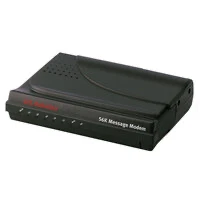
It was an electronic box allowing to connect to the internet thanks to the telephone line. This was before the arrival of ADSL, optical fiber and the mobile network. The connection was long, noisy and cut the phone line. This is the noise that everyone born before 1990 has experienced.
Listen and download more similar sounds on BigSoundBank. It's this way >
1990 › Compact disc › 2000

Developed by the Sony and Philips brands, it is a physical medium for storing data in digital form. An optical drive was required and spun the CD rapidly during playback. It has been supplanted by dematerialized media.
Listen and download more similar sounds on BigSoundBank. It's this way >
1984 › 3.5" floppy disk › 1995
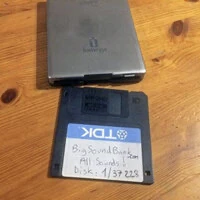
The floppy disk could store 1.44 MB of computer data. It often took a whole bunch of them to install a complete piece of software. Reading and writing was long and noisy.
Listen and download more similar sounds on BigSoundBank. It's this way >
1980 › Paper Plans and Maps › 2000
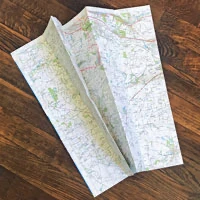
Plans and national paper maps have been slowly replaced by GPS. But before the 2000s, with almost everyone having a car, the map was the only way to navigate the roads. They are still widely used by many people to guide themselves without devices, as GPS does not show all the paths and does not work very well in many localities or conditions.
Listen and download more similar sounds on BigSoundBank. It's this way >
1980 › single-use camera › 2000

Almost entirely made of plastic, the "disposable" camera had 3 characteristic noises: The flash which recharges, the dry click as well as the winder with the noise of plastic. The camera existed in several variations: with or without flash, waterproof, ISO 200 or 400, panoramic, black & white or color, etc.
1980 › Pager › 2000

Paging, popular in the 1980s and 1990s, used devices called "pagers" or "beepers" to receive messages. Before the era of SMS and mobile phones, these devices allowed users to receive audible or vibrating notifications, often followed by short messages of around 80 characters or phone numbers to call back. The distinct sound of a pager marked the arrival of an important message. Although widely used by professionals, especially in hospitals, pagers nearly disappeared with the rise of mobile phones and SMS in the early 2000s.
No audio yet :(
1973 › Mobile phone with keys › 2007
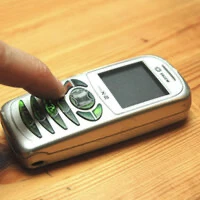
Because before phones were all touchscreen, they had keys.
Listen and download more similar sounds on BigSoundBank. It's this way >
1970 › VHS › 2000
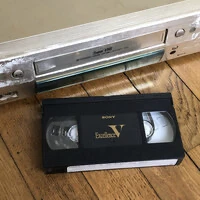
VHS (for Video Home System) is a standard for recording video signals on magnetic tape. The readers made characteristic noises that many people still have in their ears.
1969 › 16mm camera

This is the operating noise of a 16mm H16 Reflex camera (1956) from the manufacturer Bolex Paillard. In this non-motorized version, it was necessary to wind up the springs with a crank to operate the device.
Listen and download more similar sounds on BigSoundBank. It's this way >
1963 › Audio cassette › 2000

Invented by Lou Ottens, then director of Philips Audio, it is a recording medium that contains two reels around which a magnetic tape is wound. It was very successful until the appearance of CDs.
Listen and download more similar sounds on BigSoundBank. It's this way >
1958 › Rotary dial
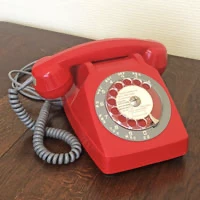
A dial of the time made it possible to dial a number. You put your finger in the hole corresponding to the number you want, you turn the dial to the metal stop and you release the dial, which returns to its initial position. The longer the return time, the further the corresponding number is from the stop and therefore in this list: 1234567890. To make this sound, I dialed my own phone number, so text me if you find out .
Listen and download more similar sounds on BigSoundBank. It's this way >
1951 › Vinyl record
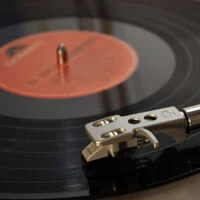
A plastic disc rotated at constant speed on a platter. A spiral-shaped "microgroove" ran from the outside to the inside of the record. A microscopic point was guided in the furrow vibrating to the rhythm of the hollows and bumps drawn in this furrow. This vibration that was amplified to listen to a recording.
Listen and download more similar sounds on BigSoundBank. It's this way >
1950 › Slide Viewer
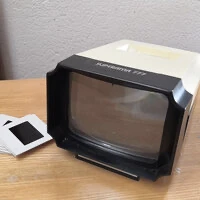
Slightly different from the slide projector, this device made it possible to comfortably view the contents of a slide alone.
Listen and download more similar sounds on BigSoundBank. It's this way >
1950 › Window crank › 2010

Gently replaced by the electric window, the crank, and its noise, we still have a special place in our memory.
No audio yet :(
1950 › VéloSoleX › 1988

Commonly called "Solex", it is a type of bike, robust, with a heat engine driving the front wheel. It was a very underpowered moped, not exceeding 40 km/h. It's a bit like the ancestor of the electrically assisted bicycle.
No audio yet :(
1950 › Slide projector

It is a projector and a lens between which is inserted a photograph in transparency. the image is therefore projected against a screen, making it possible to show photographs to a large number of people.
Listen and download more similar sounds on BigSoundBank. It's this way >
1946 › Film camera

In sound and image, it is a Kodak Six-20 Brownie C. It was assembled in Great Britain from 1946 to 1953. But film photography existed long before.
Listen and download more similar sounds on BigSoundBank. It's this way >
1940 › Hand-cranked ticket validator › 1970
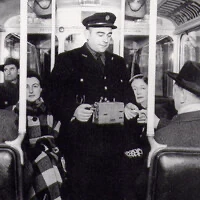
At that time, the collector issued the tickets and introduced them into the slot of his machine (nicknamed "moulinette") and gave a turn of the crank to obliterate them with a rattling noise. To obliterate means: to make a mark which makes it possible to cancel the validity.
No audio yet :(
1940 › Kitchen lighter
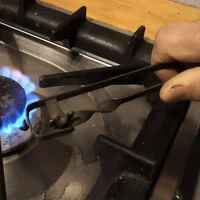
Before fuel lighters, these had a stone that sparked when handled, lighting the gas on fire. The kitchen lighter was invented by the Frenchman Henry Pingeot and marketed by Marcel Quercia. The first gas pocket lighter, the Crillon, appeared in 1948. Thanks to Brice for the research and the text.
1933 › Speaking clock (French) › 2022

Inaugurated on February 14, 1933, it is available by telephone via numbers ending with 84 00. In 1991, it became totally electronic: it is still these voices that you hear in the audio files below, recorded to tell the time until 2085. The service will be interrupted on July 1, 2022. More info on wiki.
Listen and download more similar sounds on BigSoundBank. It's this way >
1932 › 8mm projector

8 mm, also called double 8, is an amateur cinema film format launched in 1932 by Kodak using 8 mm wide film.
Listen and download more similar sounds on BigSoundBank. It's this way >
1930 › Telephone booths

The first public phone booths on the street appeared in the 1930s. These booths were installed in strategic locations such as main squares, train stations, or post offices. Today, these booths have almost disappeared due to the widespread use of mobile phones.
Listen and download more similar sounds on BigSoundBank. It's this way >
1925 › Flash-lamp › 1960

In 1925, Paul Vierkötter invented the first electric flash bulb for photography. These light bulbs produced a flash from the combustion of an agglomerate of sheets and very fine aluminum wire. These flashbulbs were single-use. They quickly replaced dangerous magnesium equipment: "Flash Powder" flashes.
No audio yet :(
1920 › Horn Ooogah

The Ooogah horn dates back to the 1920s. It was invented by the American Klaxon Company, which began producing automobile horns in 1914. The Ooogah was one of the first horns to use a metal diaphragm to produce sound. It was popular in the 1920s and 1930s, and was often used on luxury cars and trucks. Thanks to Brice for the research and the text.
Listen and download more similar sounds on BigSoundBank. It's this way >
1910 › Milk delivery › 1990
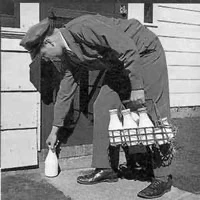
Due to the lack of good refrigeration, the milk spoiled quickly, so it was delivered fresh daily to individuals by the "milk delivery man". Their vehicles were drawn by horses or dogs, then small motorized vehicles replaced the teams. The clinking of the bottles in the metal basket is an emblematic noise of this service. Supermarkets and refrigeration have slowly replaced milk delivery, but it still exists in some emerging countries.
No audio yet :(
1905 › CRT screen › 2000

Invented in 1897, the cathode ray tube made very recognizable noises when switching on and off, but also when there was that famous "snow". With the advent of the flat screen, this technology no longer exists in our daily lives.
Listen and download more similar sounds on BigSoundBank. It's this way >
1900 › Hand-cranked mixer

The hand-cranked mixer dates from the beginning of the 20th century. It was invented by the American Rufus Eastman in 1885. The first model was called the "Egg Beater" and consisted of a crank, a whisk and a bowl. Thanks to Brice for the research and the text.
1891 › 35mm projector
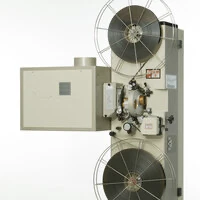
Long before the arrival of digital, movie theaters had a big projector in front of which passed a 35 mm wide tape. The tape contained 24 images for 1 second, part of which was reserved for the soundtrack. This sound is that of a 35mm cinema projector, brand Kinoton model FP30. The one I worked on when I was a projectionist.
Listen and download more similar sounds on BigSoundBank. It's this way >
1890 › Starting crank › 1950

Used to start an internal combustion engine, the starting crank was fitted to all vehicles. Before being slowly replaced by the electric starter, invented in 1910.
This sound is the crank start of a 1903 De Dion-Bouton Type Q.
1887 › Flash powder › 1925
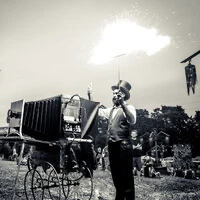
In the middle of the 19th century, the average exposure time in photography was around 30 seconds. In 1887, Adolf Mieetke and Johannes Gaedicke invented "Flashing Powder". It is an explosive mixture made of magnesium, potassium chlorate and antimony. Once ignited, its combustion provides a bright light, noise but also a lot of smoke. The first flash was born and made it possible to shorten exposure times.
Thanks to Gerry OULEVAY (GerryOulevay.ch), photographed by Chantal CODOUREY PIGUET.
1880 › Phonograph › 1920
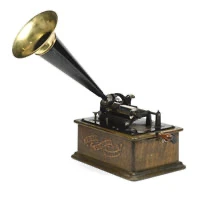
The phonograph is a device designed to record and then reproduce sound by a purely mechanical process. Thomas Edison filed the patent for the phonograph in 1877. Using tin cylinders, then wax, the rotation was ensured continuously by a crank which would later be replaced by an electric motor. The cylinders will be replaced by the records of Emile Berliner's "Gramophone".
To illustrate, here is a video of the collective "Popuri fun Yidishe Operetn" recording the piece "Kishinevskaya" on a wax roll with an "Edison 1906" model phonograph at Le Gué in Plélan-le-Grand on August 25, 2020. We see the start of the phonograph by Olivier Richaume, then the orchestra play close to the cornet so that the sound is engraved on the wax cylinder. The sound is that of the restitution of this sound by the phonograph.
No audio yet :(
1880 › Phone booth › 2000

First appearing in the 1880s, the phone booth revolutionized urban communication. By inserting coins (later cards), passersby could make calls from the street. The creak of the door, amplified by the booth’s acoustics where every sound seemed to resonate more intensely, and the clinking of coins dropping into the slot, completed this auditory experience. With the rise of mobile phones in the 1990s, these familiar sounds gradually faded away, as phone booths disappeared throughout the 2000s.
No audio yet :(
1860 › Train Rails › 2020
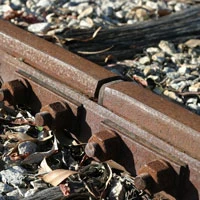
Old train tracks were assembled with mechanical joints, often fishplates, which caused the characteristic "clack-clack" sound as trains passed over them. Since the 1950s and 1960s, depending on the countries, regions, and available technologies, railway tracks have been continuously welded. This sound is gradually disappearing but can still be heard on certain secondary, tourist, or isolated lines.
1850 › Carriage › 1900
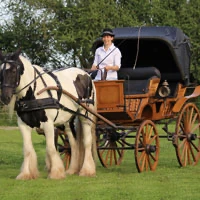
Still used for leisure and sometimes still for work, horses and their horse-drawn carriages were very present in agriculture (with plows, to work the land) and transport (with carriages), for example. Animal traction slowly gave way to cars, tractors, trucks and other motorized vehicles. The horse-drawn carriage experienced a golden age between the years 1850 to 1900 approximately.
No audio yet :(
Listen and download more similar sounds on BigSoundBank. It's this way >
1847 › Mechanical alarm clock

The mechanical spring clock, sometimes equipped with an alarm clock, worked without a battery. It had to be wound every 24 hours with a manual key to be able to function.
The characteristic sound of its mechanism is "Tic Tac".
The mechanical alarm clock was a simple clock, with an additional hand pointing to the desired wake-up time. When the hour had arrived, a small metal rod struck a small bell tirelessly.
Listen and download more similar sounds on BigSoundBank. It's this way >
1843 ›

No audio yet :(
1840 › Steam locomotive whistle › 1950
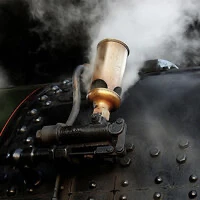
This big whistle worked thanks to the steam produced by the locomotive to move forward. We opened a tap to make the train whistle.
Listen and download more similar sounds on BigSoundBank. It's this way >
1840 › Typewriter

1840: Invention of the typewriter with ink ribbon, by Oliver T. Eddy, in Baltimore.
Listen and download more similar sounds on BigSoundBank. It's this way >
1840 › Coffee grinder

The Peugeot coffee grinder was designed in 1840. Before that many other types of grinders existed. However, in this one, the coffee beans were loaded from above, the crank was turned and the coffee powder fell into a small drawer.
Listen and download more similar sounds on BigSoundBank. It's this way >
1840 › Player piano › 1950

Invented in the 1840s, the player piano allowed music to be played without a pianist. Using perforated cards or a cylindrical pin roll, it automatically reproduced musical pieces. Some models were coin-operated, while others used a crank to activate the mechanism. The distinctive sound of its mechanically struck keys, often stiffer than human playing, filled cafés, salons, and popular gatherings. With the advent of phonographs and radios, its use declined in the 1950s, taking with it the mechanical echo of its automatic melodies.
1837 › Morse telegraph › 1920

The Morse telegraph, invented by Samuel Morse in 1837, used signals in the form of dots and dashes to transmit messages. These signals were sometimes audible, emitted by receivers producing short and long beeps. But even in the absence of intentional sound, the sending machine itself made noise: a dry, metallic clicking with each press of the telegraph key, reflecting the electrical pulses. Although it was replaced by the telephone in the 1920s, this sound marked decades of long-distance communication.
Listen and download more similar sounds on BigSoundBank. It's this way >
1830 › Sewing machine (non-motorized) › 1937

The sewing machine has been around since 1830. First made of wood, it has evolved over the years. The bobbin sewing machine (therefore two threads) was invented in 1834. The foot-operated sewing machine with a pedal was patented in 1868. They were motorized in 1937.
Listen and download more similar sounds on BigSoundBank. It's this way >
1776 › Mechanical chronograph

Intended to precisely measure the time between two events (a race start and finish, for example), the chronograph was mechanical before becoming digital. Its characteristic noise is still present in the collective memory.
Listen and download more similar sounds on BigSoundBank. It's this way >
1774 ›

Listen and download more similar sounds on BigSoundBank. It's this way >
1770 › Steam machine › 1950

Used in industry, mills, boats, vehicles or locomotives, the steam engine is an engine using water vapor as energy. It is therefore necessary to heat water, the pressure of the steam then actuates pistons and then wheels to drive an industrial machine or a vehicle.
No audio yet :(
1739 › Mechanical spring winder
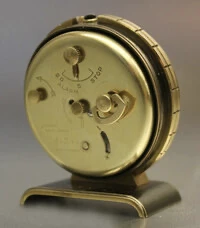
The spring winder was invented by English watchmaker John Harrison. It has been widely used in watchmaking as well as in toys, music boxes, automatons...
Listen and download more similar sounds on BigSoundBank. It's this way >
1680 › Longcase pendulum clock › 1915

Bell of a comtoise-type longcase pendulum clock, striking the exact hour.
Listen and download more similar sounds on BigSoundBank. It's this way >
1669 › Libra Roberval › 1980

Invented around 1669 by Gilles personne, the production of the Roberval balance became important from 1850.
1505 › Barrel organ › 1950

It is a mechanical wind musical instrument classified as an organ. It is one of the “automatophones”. Very widespread, we all imagine the music of old carousels.
No audio yet :(
1500 › Wooden clog › 1880

The clog is originally a shoe made by hollowing out a piece of wood. It appeared between 1480 and 1520. It was the peasants who made the greatest use of it before 1880.
Listen and download more similar sounds on BigSoundBank. It's this way >
1450 ›

No audio yet :(
1433 › Arm pump
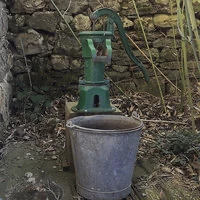
Listen and download more similar sounds on BigSoundBank. It's this way >
1300 › Grinder › 1950

Also called grinder or ironer, he is a craftsman who sharpens the blades of sharp instruments (knives, scissors, etc.) with a grinder. Often itinerant, he once moved from town to town with a small mobile millstone.
No audio yet :(
1300 › Spinning wheel › 1800

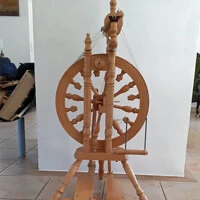
A spinning wheel is a device for spinning thread or yarn from fibres.
900 › Roman scales › 1940
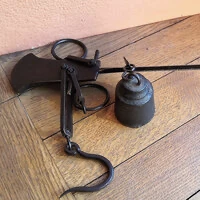
It is an object equipped with a hook to fix the thing to be weighed, a ring to hold the balance and a counterweight intended to find the point of balance. When the object is in balance, the position of the counterweight indicates the mass, often by a number engraved on the balance.
500 › Town crier › 1950

Announcing himself with a bell, a drum or a trumpet, the town crier was important in the Middle Ages, until the middle of the 20th century. This itinerant profession is still somewhat present in certain countries (Africa, United Kingdom, Canada and Australia), during particular events (such as Frédéric Ganga at the La Ciotat market), in a few localities or for specific reasons (In Africa South, the "whale crier" is responsible for announcing the arrival of cetaceans in the bay and where they can be observed).
No audio yet :(
300 › Dip pen › 1820

Before the metal "fountain pen", we used real feathers to write (goose, turkey, crow, capercaillie and duck).
250 BC › Watermill

Appearing for the first time in 250 BC, it is a technological system allowing the current of a river to be used to operate a rotating machine.
Listen and download more similar sounds on BigSoundBank. It's this way >
3 100 BC › Sword › 1600

swords were used in hand-to-hand combat. Unfortunately, humans have since developed far more lethal weapons, so sword sounds are a thing of the past.
3 500 BC › Parquet brush

The parquet brush dates from Antiquity. The first models were made from natural materials, such as plant fibers or animal hair. They were used to clean and polish wooden floors. The exact dates of Antiquity may vary depending on the sources. However, the period is generally considered to extend from 3500 BC. to 476. Thanks to Brice for the research and the text.
10 000 BC › Mortar and pestle
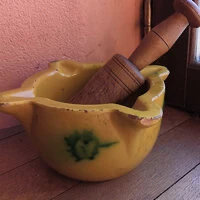
The mortar and pestle are kitchen tools that have been used for thousands of years. The first mortars and pestles were made from stones or bones, and they were used to grind foods, herbs, and spices. The first mortars and pestles were discovered in North Africa and Southeast Asia. They date from around 10,000 years ago. Mortars and pestles were introduced to Europe during the Neolithic period, around 6,000 years ago. Thanks to Brice for the research and the text.
300 000 BC › Fire (firesteel) › 450

Contrary to popular belief, you don't hit two flints. Fire by percussion is: hitting an iron sulphide (marcasite or pyrite) using a hard stone (flint, quartz, granite or even another nodule of iron sulphide) above a combustible such as as flammable mushroom powder (tinder) or certain plant marrows. When the fuel begins to take, it is necessary to add a few dry plants and to blow so that the flames appear.
Here is a short explanatory video.
300 000 BC › Fire (friction)

The technique requires a "fire board" with a small hole and notch. A "drill" (or "rod"), must be rotated rapidly in the notch, with or without a "fire arc" (or "bow"), to generate embers which will fall onto the fuel placed just below . Blowing on the embers will ignite a flame that will need to be maintained quickly.
No audio yet :(
2 500 000 BC › Stone cutting

Stone cutting has been around for a very long time. Techniques have evolved greatly, from flint cutting to dynamite explosions, including hammers and chisels...
No audio yet :(
Listen and download more similar sounds on BigSoundBank. It's this way >
3 000 000 BC › Kauaʻi ʻōʻō › 1987
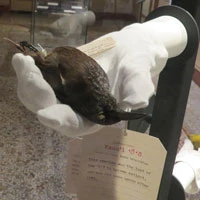
The Kauaʻi ʻōʻō
, an iconic songbird of the Hawaiian archipelago, was last seen in 1985. Its unique song, recorded for the final time in 1987, now echoes as a distant reminder of a species lost forever.
No audio yet :(
But still ?
If you are interested in the topic, also search for the term "Sound Archaeology" on your favorite search engine. It brings together a whole bunch of very interesting research on the "soundscape memory", thanks to renowned researchers such as "Mylène PARDOEN", whose here is the work. By the way, here is a very interesting interview with her, on France Culture (in french).
If you have any suggestions, ideas, contact me!
Museum exhibition
The exhibition of this museum is easy thanks to a sound diffusion system. BigSoundBank has developed one perfectly intended for this type of sound installation: "Exposi'Son".
Thanks
Thanks to Clara and Gilles SARDIN, my parents, for their help, numerous recordings and photos.
♥ - Joseph SARDIN - Founder of BigSoundBank.com - About - Contact


